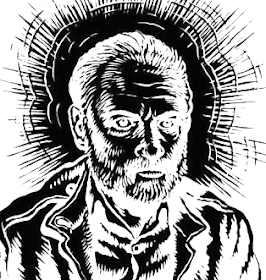If you are science fiction reader, you know Dick's writing. If you aren't, but are a movie-goer, then you probably know him from pictures that have been adapted from his work: Blade Runner*, Total Recall, Screamers, Minority Report and Paycheck.
Dick, whose output of SF novels was prodigious–mostly fueled by amphetamines–died in 1982. In a Rolling Stone interview, Dick once claimed that the first book he wrote when he wasn't on speed was A Scanner Darkly, published in 1977, which means that forty-some odd novels–some of them very odd, and some of those manuscripts lost and hitherto undiscovered–were cranked out while under the influence over the course of twenty-five or so years. This would include the Hugo-winning, The Man in the High Castle. He was fast, routinely writing three or four books a year, and one report I remember reading years ago said he once wrote four books in one summer.
Dick admitted to experimenting with other drugs, and Harlan Ellison once made the comment that a story Dick had written for one of the the Dangerous Visions anthologies was done on LSD resulted in a public feud that ended their friendship. Harlan's comment was probably not meant to be literal–writing anything under the direct influence of acid during a trip would be a notable accomplishment. Dick said that he tried once, and what resulted was a page of Latin with some Sanskrit thrown in ...
However, Dick apparently did more than dabble with acid. According to an article by Philip Purser-Hallard in The Guardian, published when the movie version of A Scanner Darkly came out:
"In 1960s California it was inevitable that a writer like Dick would become a counterculture guru, expected - practically obliged, in fact - to flaunt a drug-rich lifestyle of his own, and he rose enthusiastically to that challenge. His writing had always been fuelled by vast quantities of amphetamines, but he soon branched out into marijuana, mescaline, LSD, sodium pentothal and even PCP. After the breakup of his fourth marriage in 1970, Dick's home became open house to the eclectic collection of speed-freaks, dope-heads, junkies and dealers on whom the characters in A Scanner Darkly are based."
Purser-Hallard's article allowed as how the drugs worked in Dick's case, driving his stories, albeit they hastened his demise, rotting his liver and pancreas.
In March of 1977, Dick had a religious experience triggered by a delivery woman's necklace that he apparently spent the rest of his life trying to sort out–all of his subsequent work was connected to this, and it seemed to have tipped him over the edge.
Purser-Hallard:
"The apparently mundane arrival of a delivery woman whose necklace bore a Christian fish symbol had triggered a cascade of bizarre impressions. He thought his unplugged radio was insulting him, his cat was trying to tell him something of vital significance, and that the KGB were sending him post-hypnotic triggers in the mail.
"Taking a truly enormous dose of vitamin C to help him cope, Dick believed that pink laser beams from space were firing information into his brain, beginning with thousands of paintings flashing past his eyes - works by Klee, Kandinsky and Picasso, but far more than any of them could have painted in a lifetime."
In 1982, he had two major strokes and died. He was fifty-three.
* The Dick story upon which the movie Blade Runner was based on "Do Androids Dream of Electric Sheep?" Alan Nourse, (pronounced closer to "nurse,") had written a novel, The Bladerunner, published in 1974, which had nothing to do with Dick's story, but whose rights to use the title were bought by Ridley Scott. Scott also bought the rights to the title of an unproduced script by, of all people, William S. Burroughs, which also used Nourse's title, just to be on the safe side.
What I've always found amusing is that Alan Nourse (1928-1992) was a physician as well as a writer. So when he was addressed at the clinic, it would have sounded a lot like "Doctor Nurse ..."

No comments:
Post a Comment